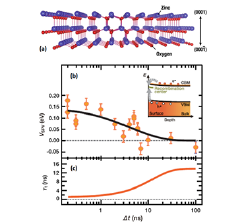Electron-Hole Recombination on ZnO(0001) Single-Crystal Surface Studied by Time-Resolved Soft X-Ray Photoelectron Spectroscopy
I. Matsuda Group
Zinc oxide (ZnO) has attracted much attention for its optoelectronic applications, e.g. photovoltaics, light-emitting diode, and photocatalyst. One of the important factors in the photo-induced function is dynamics of photoexcited carriers that govern optical and electronic phenomena, and their lifetime is directly related to efficiency of the optoelectronic functionalities. Recently, time-resolved photoemission spectroscopy has been carried out to trace relaxation of the photovoltage effect on various semiconductor surfaces. The relaxation is a consequence of decay of the photo-excited carriers or electron-hole (e-h) recombination and, thus, the decay constant of surface photovoltage (SPV) directly corresponds to the lifetime of photoexcited carriers. In the present research, we report the detailed investigation of the time-resolved soft X-ray PES experiments on a ZnO(0001) surface to clarify the carrier dynamics [1].

Fig. 1. (a) Atomic structure of an ideal ZnO crystal. Time-dependences of (b) surface photovoltage, VSPV, taken with the laser intensity of 113 mJ/cm2/pulse, and (c) carrier lifetime (τt) during the relaxation of the SPV effect. The inset shows the schematic drawing of electron-hole recombination at or near the surface. In (b), the data points are curve-fitted with the thermionic model. Variation of τt is obtained with τt = τ0 exp {(Vs – VSPV)/ηkT}, where η=2.0 and τo=1.7 ps.
A ZnO crystal has wurtzite structure and the (0001) surface is terminated with zinc atoms (Fig. 1(a)). The e-h pairs are generated by the irradiation of the femtosecond-pulse laser, and the following charge separation leads to the SPV generation. The relaxation of the SPV was found to take nanoseconds, as shown in Fig.1(b). The relaxation process is fairly described by a thermionic model, in which the photoexcited carriers overcome the surface potential, Vs, to be transported to the surface and then recombine with the counterparts accumulated at the surface. The potential, generated by the bulk band-bending effect near the surface and the Vs value, was evaluated by valence band photoemission spectroscopy measurements of the sample surface. By tracing the relaxation of the SPV effect, we determined a photoexcited carrier lifetime at the surface under the flat band condition on the ZnO(0001) surface to be τo=1.7 ps and the lifetime exponentially increases with temporal variation of surface potential barrier (Fig.1(c)). The obtained carrier lifetime at the surface matches with values of the surface carrier decay time (~1ps) reported in the literatures of femtoseconds-time-resolved reflectivity and transmissivity experiments [2]. The agreement implies the relaxation of the SPV effect on the ZnO(0001) crystal proceeds with thermal diffusion of photo-excited carriers and the e-h recombination was evaluated to held at the depth of 30–100 nm from the surface. It has been discussed that the density of singly ionized oxygen vacancy traps (which can be the recombination centers) is much higher in such a surface recombination layer than in the interior of the crystal. It is inferred that e-h recombination takes place at the trapping sites at the topmost surface (the surface state) and in the subsurface layer (the impurity states) with the different carrier-capturing cross-sections. The understanding leads to both developments of a new optoelectronically functional materials and improvements of the efficiency.
References
- [1] R. Yukawa, S. Yamamoto, K. Ozawa, M. Emori, M. Ogawa, Sh. Yamamoto, K. Fujikawa, R. Hobara, S. Kitagawa, H. Daimon, H. Sakama, and I. Matsuda, Appl. Phys. Lett. 105, 151602 (2014).
- [2] M. A. M. Versteegh, T. Kuis, H. T. C. Stoof, and J. I. Dijkhuis, Phys. Rev. B 84, 035207 (2011).
